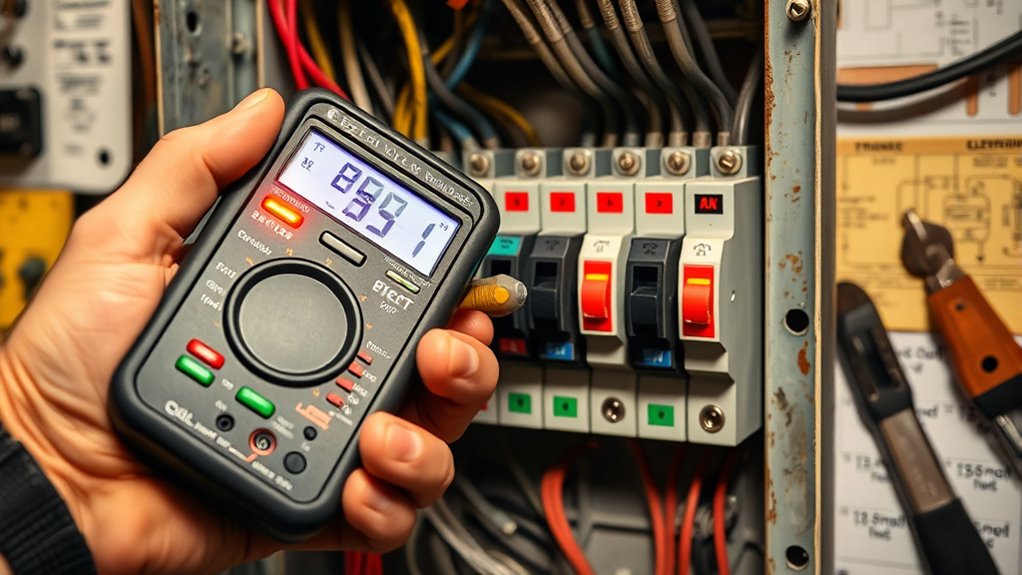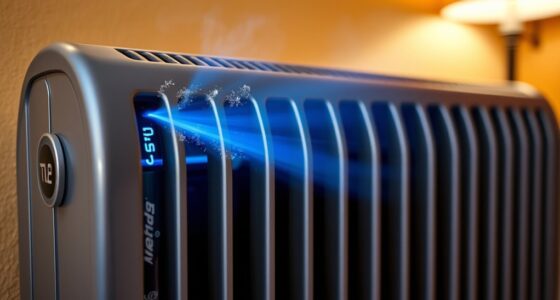To understand heater trips and breaker codes, you need to recognize common causes like overloads, faulty wiring, or thermostat issues that trip breakers to prevent damage. Always follow key regulations such as the NEC and local codes to guarantee safety and compliance. Use troubleshooting techniques like inspecting wiring and testing components. Regular maintenance and safety measures keep your system running smoothly and safely. Continue exploring these rules to avoid future problems and stay compliant.
Key Takeaways
- Understand breaker codes to accurately diagnose heater trips and identify underlying electrical issues.
- Follow national and local electrical standards, including NEC, for proper breaker sizing and wiring safety.
- Regularly inspect wiring, insulation, and components to prevent overloads and short circuits causing trips.
- Use troubleshooting techniques like testing voltage and inspecting connections to pinpoint trip causes effectively.
- Maintain safety signage, conduct safety training, and perform routine maintenance to ensure ongoing compliance and safety.
Understanding Heater Trips and Breaker Codes

Heater trips occur when a breaker detects an issue and shuts off power to prevent damage or safety hazards. This automatic response is crucial for electrical safety, protecting both you and your system. Understanding breaker codes helps you identify why your heater trips, which is essential for proper heater maintenance. When a breaker trips, it signals that something isn’t right—whether it’s an overload, short circuit, or faulty wiring. Ignoring these codes can lead to more serious problems or safety risks. Regular heater maintenance can help prevent unnecessary trips by ensuring all components are functioning correctly and safely. By recognizing what causes these trips and understanding breaker codes, you stay proactive in maintaining a safe, efficient heating system, reducing downtime and potential hazards.
Recognizing the Common Causes of Trips and Codes

Many issues can cause a breaker to trip or display a code, often indicating underlying electrical problems. One common cause is a thermostat malfunction, which can send incorrect signals, causing the heater to overwork or shut down unexpectedly. Overload protection is another frequent culprit; if your heater draws too much current, the breaker trips to prevent damage. Faulty wiring or damaged components can also trigger trips, especially if they cause short circuits or overloads. Additionally, a clogged air filter or dirty components can make the system work harder, increasing the risk of overload protection activation. Regular maintenance and prompt repairs are essential for keeping your heater operating smoothly and avoiding unnecessary trips. Using appropriate headphones can help monitor the system quietly during troubleshooting to detect unusual sounds or vibrations indicating electrical issues.
The Key Regulatory Standards You Must Follow

To guarantee safety and compliance, understanding the key regulatory standards governing heater breaker codes is vital. These standards ensure proper heater maintenance and specify breaker requirements. You must follow the National Electrical Code (NEC) and local building codes to avoid violations and hazards. Proper breaker specifications help prevent trips caused by overloads or faults. Here’s a quick overview:
| Standard | Focus |
|---|---|
| National Electrical Code (NEC) | Specifies breaker sizing and wiring safety |
| Local Regulations | Enforce regional safety and installation rules |
| Manufacturer Guidelines | Ensure correct heater maintenance and breaker use |
Additionally, staying informed about One Bored Mommy resources can help you understand and implement these safety standards effectively.
Troubleshooting Techniques for Accurate Diagnosis

Accurate diagnosis of breaker trips requires a systematic approach to troubleshooting. Start by observing if the breaker trips during specific operations or randomly. Check for signs of thermal overload, such as overheating or a burnt smell, which indicates the breaker may be overheating due to excessive current. Conduct a thorough wiring inspection to identify loose, damaged, or improperly connected wires that could cause short circuits or overloads. Use a multimeter to test continuity and voltage levels, ensuring the wiring aligns with manufacturer specifications. Always disconnect power before inspecting wiring or testing components to prevent injury. By carefully evaluating thermal overload conditions and inspecting wiring integrity, you can pinpoint the root cause of the trip more effectively and avoid unnecessary replacements or safety hazards. Additionally, understanding self-watering plant pots can help you recognize how consistent moisture levels might influence electrical components if used improperly near electrical systems.
Preventive Measures to Ensure Compliance and Safety

Implementing preventive measures is essential to maintaining compliance and ensuring safety when working with breaker systems. You should regularly inspect electrical insulation to prevent shorts and electrical failures that could lead to breaker trips. Proper electrical insulation minimizes the risk of accidental contact and equipment damage. Additionally, visible safety signage plays a vital role in alerting personnel to potential hazards and proper procedures. Ensure signage is clear, up-to-date, and placed in prominent locations around breaker panels. Consistent training on safety protocols, combined with these preventive steps, helps you recognize issues early and avoid violations. By prioritizing electrical insulation checks and maintaining effective safety signage, you reinforce a safety-first environment that promotes compliance and reduces the risk of accidents. Regularly monitoring juice extraction processes and equipment maintenance can also help prevent system failures that lead to breaker trips.
Frequently Asked Questions
How Often Should Heater Trip Breakers Be Inspected for Compliance?
You should inspect heater trip breakers during annual maintenance and safety inspections to guarantee compliance. Regular checks help identify potential issues early, preventing possible hazards. By routinely testing and inspecting these breakers, you maintain safety standards and avoid costly downtime. Schedule these inspections consistently, ideally once a year, and immediately if you notice any signs of malfunction or unusual operation. Staying proactive keeps your system safe and compliant.
Are There Specific Tools Required to Decode Breaker Trip Codes?
Like a modern detective on a mission, you don’t need fancy tools to decode breaker trip codes. Usually, a multimeter or a circuit tester suffices for breaker testing and fault detection. These tools help you read the trip indicator or diagnostic LEDs, making it easier to identify issues quickly. Keep a digital multimeter handy, and you’ll be able to troubleshoot effectively, ensuring your breaker operates safely and complies with regulations.
What Are the Legal Penalties for Non-Compliance With Heater Breaker Regulations?
If you ignore heater safety and breaker regulations, you could face legal penalties like fines, lawsuits, or even criminal charges. Non-compliance can also lead to safety violations, insurance issues, and increased liability if accidents occur. Staying compliant with breaker regulations protects you legally and ensures safe operation. Always follow regulations carefully, use proper tools for decoding breaker trip codes, and prioritize heater safety to avoid costly penalties and potential harm.
Can DIY Repairs Void Safety Certifications or Warranties?
Doing DIY repairs can void your safety certifications and warranty concerns. When you attempt to fix heater breakers yourself, you risk improperly handling electrical components, which may lead to safety hazards or damage. Manufacturers often specify that only qualified professionals should perform repairs to maintain warranty coverage. So, if you ignore these guidelines, you might lose your warranty and compromise your safety, potentially leading to costly repairs or legal issues.
Are There Industry-Specific Standards for Heater Breaker Code Compliance?
Yes, there are industry standards for heater breaker code compliance. You need to follow specific breaker specifications that guarantee safety and proper operation. These standards vary depending on your location and the type of heater, so it’s essential to consult local electrical codes and manufacturer guidelines. By adhering to these industry standards, you help prevent electrical hazards and ensure your heater functions reliably and safely.
Conclusion
By understanding heater trips, breaker codes, and how to troubleshoot, you’re better equipped to keep your system safe and compliant. Following key regulations and practicing preventive measures help you avoid unnecessary headaches down the road. Remember, it’s better to stay ahead of the game than to fix problems after they’ve spiraled out of control. Stay vigilant, follow the rules, and you’ll keep your heater running smoothly—because a stitch in time saves nine.









